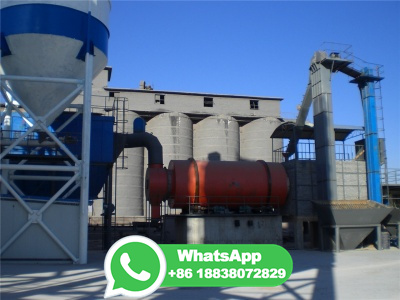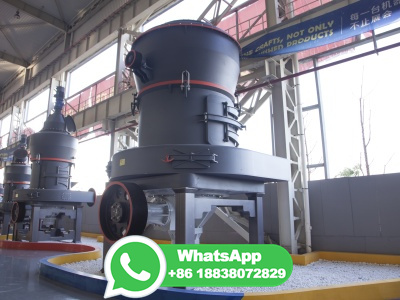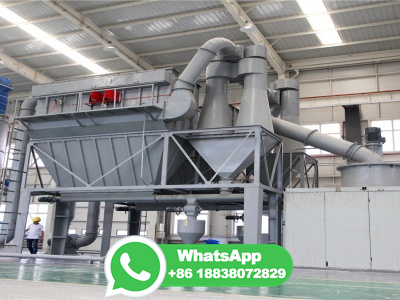
WEBJun 20, 2002 · It has also been shown that the properties of metallurgical cokes can differ greatly depending on the characteristics of petroleum coke and coal/blend used [8]. Green petroleum coke can interact with coal during the cocarbonization process, as has been confirmed using a series of green petroleum cokes characterized by nonconventional .
WhatsApp: +86 18203695377
WEBApr 26, 2013 · Download Study notes Blast Furnace Materials and Heat Balance in Metallurgical Processes ... How coke is produced Coke is produced by heating coal to high temperature T 1000 1100 out of contact of air until all volatile matters are removed. The process is called "carbonization" or "Destructive distillation of coal". ...
WhatsApp: +86 18203695377
WEBJan 11, 2020 · It is also used to produce iron in a blast furnace. Coke is used to manufacture steel and many other materials. What is metallurgical coke and how is it made? Metallurgical coke is an important raw material for pig iron production in the blast furnace. During this process the coke undergoes severe mechanical, thermal and .
WhatsApp: +86 18203695377
WEBJun 1, 2021 · Metallurgical coke is a common material used for hot metal production in blast furnaces. ... around 40% of the coal without change the process and bring some economics and environmental gains ...
WhatsApp: +86 18203695377
WEBApr 1, 2011 · Briquetting results showed that was possible to obtain coke having % CRI and % CSR, these being the characteristics required in metallurgical processes. Differential and cumulative size ...
WhatsApp: +86 18203695377
WEBFeb 3, 2022 · Supported by cleaner production, the global steel market is forecast to grow by 557 million tonnes during, progressing at a compound annual growth rate (CAGR) of %. As demand for ...
WhatsApp: +86 18203695377
WEBMetallurgical coal, also known as coking coal, is used in the steelmaking process to create coke. Coke is a key component in blast furnace iron smelting, as it provides the necessary carbon for ...
WhatsApp: +86 18203695377
WEBThese ultrafine coal particles, although they are good quality due to their nature and origin, cannot be used directly in coking because of handling problems (Wen, 2000). However, because of the high cost of coking coal, it is necessary to find alternatives for their use in producing metallurgical coke and so coal iquetting is a good alternative.
WhatsApp: +86 18203695377
WEBJan 6, 2022 · The coke reactivity index and coke strength after reaction are critical parameters for the efficient operation of a blast furnace. Therefore, maintaining desired qualities of the produced coke as per coal blend chemistry and coke oven battery parameters is essential. However, the coke reactivity index (CRI) and coke strength .
WhatsApp: +86 18203695377
WEBOct 31, 2023 · Coke is a critical fuel used in the steelmaking process that is created by heating metallurgical coal. Metallurgical coal, which is produced in West ia, is in return a key component in the production of steel. The West ia Democrat said the new EPA rule will hurt the Mountain State.
WhatsApp: +86 18203695377
WEBA lack of a reliable supply of individual coal grades means that cokemakers today often use blends of up to 20 different coals in order to offer steelmakers a consistent product. Approximately metric tons of metallurgical coal are required to produce 1 metric ton (1,000 kilograms) of coke. A blast furnace is fed with coke, iron ore and ...
WhatsApp: +86 18203695377
WEBApr 1, 2023 · Biocoke is a char prepared from a mixture of biomass/charcoal and a coal blend and can reduce greenhouse gas emissions by replacing coke and reducing coal consumption in the ironmaking process.
WhatsApp: +86 18203695377
WEBMay 1, 2011 · Biomass char or biochar, a pyrolysis product of biomass, is an excellent solid fuel with. high reactivity and puri ty, low in sulfur and ash content. Biomass has favorable metallurgical ...
WhatsApp: +86 18203695377
WEBJul 1, 2020 · Coke is the major fuel as well as the costliest raw material of the blast furnace ironmaking process. It is not only the major reductant of the process, but it also provides strength to the burden under blast furnace conditions. Total cost of coke is around 60% of the hot metal production and 1/3rd of the steelmaking production cost in whole.
WhatsApp: +86 18203695377
WEBMay 20, 2008 · The use of biomass in metallurgical coke production has been identified as one of the main possibilities to introduce a renewable carbon source to the process chain of blast furnace based steel ...
WhatsApp: +86 18203695377
WEBSep 28, 2016 · Coke is a porous, highstrength carbon material produced by heating coal in ovens without oxygen. It is a key material used in blast furnaces for ironmaking. Metallurgical coke is made specifically from bituminous coal that can withstand high heat and pressures. The coking process involves heating coal to around 2000°F for 1236 .
WhatsApp: +86 18203695377
WEBMetallurgical Coal. Metallurgical coal, also known as coking or steelmaking coal, or simply "met coal", is a carbonrich, black sedimentary rock with high density, hardness, porosity and reflectivity. More than 70% of global steel production is from iron produced in blast furnaces, using coke derived from metallurgical coal, with an average ...
WhatsApp: +86 18203695377
WEBApr 18, 2018 · Coal rather than coke is used for heat generation, production of reducing gases and to maintain adequate bed permeability; hence, coals have to meet certain physical, chemical and especially high ...
WhatsApp: +86 18203695377
WEBMetallurgical coal is essential for steel production, while thermal coal is primarily used for electricity generation. Both types of coal have significant environmental consequences, but efforts are being made to mitigate their impacts. As the world transitions towards cleaner energy sources, the demand for both metallurgical coal and thermal ...
WhatsApp: +86 18203695377
WEBDec 9, 2023 · It is a noncoking ironmaking process in which noncoking coal is used as the main energy source to reduce ferrous oxides and achieve slagiron separation in a hightemperature melting state to obtain carboncontaining iron melt. In the 1960s, the Swedish metallurgist S. Eketorp called it smelting reduction in order to distinguish this method ...
WhatsApp: +86 18203695377
WEBJan 10, 2008 · The quality of coke, as much as 7080%, depends on the coal type, coal rank, maceral composition, and/or blending additives, and the remaining 2030% depends on the operational parameters like ...
WhatsApp: +86 18203695377
WEBCoal is a combustible black or brownishblack sedimentary rock, formed as rock strata called coal is mostly carbon with variable amounts of other elements, chiefly hydrogen, sulfur, oxygen, and nitrogen. Coal is a type of fossil fuel, formed when dead plant matter decays into peat which is converted into coal by the heat and pressure of deep .
WhatsApp: +86 18203695377
WEBApr 1, 2023 · A. ElTawil B. Björkman M. Lundgren A. Robles Lena Sundqvist Ökvist. Environmental Science, Materials Science. Metals. 2021. Coke corresponds to 2/3–3/4 of the reducing agents in BF, and by the partial replacement of coking coals with 5–10% of biocoal, the fossil CO2 emissions from the BF can be lowered by ~4–8%. Coking..
WhatsApp: +86 18203695377
WEBOct 15, 2023 · Coke produced from metallurgical coal after coking treatment is used in the blast furnace (BF). Coal does not have adequate strength and porosity to make it a suitable fuel for blast furnace appliion. Coke acts as a reductant, holds the overlying burden and provides thermal energy in the blast furnace. Metallurgical coke should .
WhatsApp: +86 18203695377
WEBSep 7, 2018 · Coal, coke and the prediction of their properties. Metallurgical coke, derived from the pyrolysis of selected coals, plays several critical roles in the ironmaking blast furnace (Babich and Senk 2013; Bertling 1999; Biswas 1981).As a structural support, and source of permeability for the layers of softening iron materials, the selection of an .
WhatsApp: +86 18203695377
WEBDec 27, 2021 · performance in the blast furnace. This review divides coke structures into chemical structure, physical. structure, and optical texture according to their relevant characteristics. The focuses of ...
WhatsApp: +86 18203695377
WEBSiC is one of the main intermediate compounds formed during the industrial production of silicon (Si). In the Si process, SiC is produced when carbon added to the raw materials reacts with the silicon monoxide gas (SiO(g)) formed in the furnace. Carbon materials used are either biomassbased (charcoal and wood chips) or based on fossil sources (coal, .
WhatsApp: +86 18203695377
WEBSep 11, 2019 · Coking. Coke is an extremely important and the most expensive feedstock for iron and steelmaking, being obtained from nonrenewable specificrank coals or blended coal using a hightemperature carbonization process (> 1100°C).31,32 It has multiple roles in the BF during ironmaking,33,34, as an agent for reduction of reducible oxides and .
WhatsApp: +86 18203695377
WEBJan 1, 2019 · Metallurgical coke is produced from lowash, lowsulfur coking coals in the coking process involving devolatilization and carbonization at ~ 1000–1100°C in airless ovens over 18–20 h. Volatile hydrocarbon byproducts are later used to generate energy in separate combustion processes.
WhatsApp: +86 18203695377
WEBMay 1, 2011 · The whole formed coke production process involving air blown coal tar pitch preparation, its blending with molasses containing hardeners, such as ammonium carbonate, ammonium nitrate and nitric acid of varying amount, and mixing the binder with ground anthracite fines or coke breeze, briquetting and curing the green briquettes, .
WhatsApp: +86 18203695377
WEBThree of the coals produced coke with equivalent coke reactivity index values of 20–30, which are in the acceptable range for blast furnaces. The study demonstrated that via this process, noncoking coals could potentially be used to produce high quality cokes, potentially expanding the raw material options for metallurgical coke production.
WhatsApp: +86 18203695377
WEBMay 10, 2022 · The replacement of pulverised coal injection (PCI) coal with hydrogen in blast furnaces looks like being an early decarbonising appliion. Lowercost PCI coal is injected into blast furnaces to reduce coking coal consumption. Essentially highquality thermal coal, PCI coal can be sold into either the metallurgical or thermal coal markets.
WhatsApp: +86 18203695377
WEBNov 17, 2011 · A comparative analysis is made of greenhousegas emissions by alternative cokeless metallurgical processes for making pig iron, metallized pellets, and steel. The concept of technological greenhouse number is used in the analysis. Specific data obtained as part of an environmentalenergy analysis of the given processes show that DAV .
WhatsApp: +86 18203695377